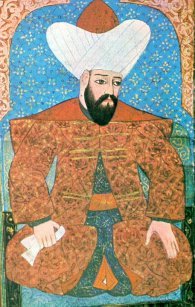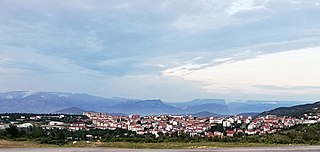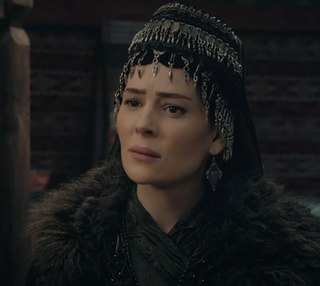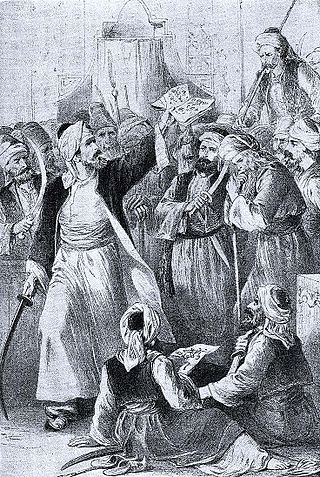
Osman I or Osman Ghazi was the founder of the Ottoman Empire. While initially a small Turkoman principality during Osman's lifetime, his beylik transformed into a world empire in the centuries after his death. It existed until shortly after the end of World War I.

Orhan Ghazi was the second sultan of the Ottoman Empire from 1323/4 to 1362. He was born in Söğüt, as the son of Osman I.

The Ottoman Turks were a Turkic ethnic group. Originally from Central Asia, they migrated to Anatolia in the 13th century and founded the Ottoman Empire, in which they remained socio-politically dominant for the entirety of the six centuries that it existed. Their descendants are the present-day Turkish people, who comprise the majority of the population in the Republic of Turkey, which was established shortly after the end of World War I.

Ertuğrul or Ertuğrul Ghazi was a 13th-century bey, who was the father of Osman I. Little is known about Ertuğrul's life. According to Ottoman tradition, he was the son of Suleyman Shah, the leader of the Kayı tribe of the Oghuz Turks. These Turkomans fled from western Central Asia to Anatolia to escape the Mongol conquests, but he may instead have been the son of Gündüz Alp. According to this legend, after the death of his father, Ertuğrul and his followers entered the service of the Sultanate of Rum, for which he was rewarded with dominion over the town of Söğüt on the frontier with the Byzantine Empire. This set off the chain of events that would ultimately lead to the founding of the Ottoman Empire.

Söğüt is a town in Bilecik Province, Turkey. It is the seat of Söğüt District. Its population is 13,566 (2021). The mayor is İsmet Sever (MHP), elected in 2019.

The rise of the Ottoman Empire is a period of history that started with the emergence of the Ottoman principality in c. 1299, and ended c. 1453. This period witnessed the foundation of a political entity ruled by the Ottoman Dynasty in the northwestern Anatolian region of Bithynia, and its transformation from a small principality on the Byzantine frontier into an empire spanning the Balkans, Anatolia, Middle East and North Africa. For this reason, this period in the empire's history has been described as the "Proto-Imperial Era". Throughout most of this period, the Ottomans were merely one of many competing states in the region, and relied upon the support of local warlords Ghazis and vassals (Beys) to maintain control over their realm. By the middle of the fifteenth century the Ottoman sultans were able to accumulate enough personal power and authority to establish a centralized imperial state, a process which was brought to fruition by Sultan Mehmed II. The conquest of Constantinople in 1453 is seen as the symbolic moment when the emerging Ottoman state shifted from a mere principality into an empire therefore marking a major turning point in its history.

Kameriye Malhun Hatun was the second legal wife of Osman I, the leader of the Ottoman Turks and the founder of the dynasty that established and ruled the Ottoman Empire. She was the mother of Sultan Orhan.

The Battle of Bapheus occurred on 27 July 1302, between an Ottoman army under Osman I and a Byzantine army under George Mouzalon. The battle ended in a crucial Ottoman victory, cementing the Ottoman state and heralding the final capture of Byzantine Bithynia by the Ottomans.
Köse Mihal accompanied Osman I in his ascent to power as a bey and founder of the Ottoman Empire. He is considered to be the first significant Byzantine renegade and convert to Islam to enter Ottoman service.
The Abaza rebellion is the name given to uprisings that occurred in the 17th century in the Ottoman Empire during the reigns of Mustafa I (1622–23) and Murat IV (1623–40). The name of the rebellion refers to Abaza Mehmet, an Ottoman pasha of Abkhazian origin. Sometimes, this event is considered as a part of the Jelali revolts. But unlike the other Jelali revolts the principal reason of the Abaza rebellion was the resentment towards the janissary corps.
Hayme Hatun, also known as Hayma Ana, was the grandmother of Osman I, founder of the Ottoman Empire and the mother of Ertuğrul Gazi, Gündoğdu and the leader of the Kayı clan of the Oghuz Turks. She was bestowed and known by the title of Devlet Ana of the Ottoman Empire.
Kaya Alp was, according to Ottoman tradition, the son of Kızıl Buğa or Basuk and the father of Suleyman Shah. He was the grandfather of Ertuğrul Ghazi and great grandfather of the Ottoman Empire founder, Osman I. He was also famously known for being the successing name of Ertokus Bey’s son Kaya Alp. He was a descendant of the ancestor of his tribe, Kayı son of Gun son of Oghuz Khagan, the legendary progenitor of the Oghuz Turks.

Turgut Alp was one of the warriors and alps who fought for Ertuğrul, a Turkoman leader and bey, and Ertuğrul's son Osman I, the founder of the Ottoman Empire. After the establishment of the Empire, he became one of its military commanders, serving Osman I, as well as his son, Orhan Gazi.
Kuruluş: Osman is a historical fiction Turkish television series produced by Bozdağ Film. The first episode of the series, directed by Metin Günay and written by Mehmet Bozdağ, was aired on November 20, 2019, on the ATV network. The show is a continuation of the TRT 1 series Diriliş: Ertuğrul, which aired between 2014 and 2019.

Saru Batu Savcı Bey was the older brother of Osman I, the founder of the Ottoman Empire. He is known to be the most 'mysterious' of Ertuğrul's children.

Osman Bey is the main protagonist in the Turkish TV series, Kuruluş: Osman, portrayed by Burak Özçivit. He also appears as a supporting character in its predecessor, Diriliş: Ertuğrul, where he is played by Emre Üçtepe. The character is based on Osman I, founder of the Ottoman Empire.

Malhun Hatun is a main character in the Turkish TV series Kuruluş: Osman portrayed by Yıldız Çağrı Atiksoy. She is based on Malhun Hatun, wife of Osman Gazi. She is the second wife of the character Osman Bey.

The siege of İnegöl took place between Agios Nikolaos, the governor of the fort, and the Kayı army under the command of Turgut Bey. This conquest was one of the first conquests in Ottoman history after the siege of Kulaca Hisar. After the end of the siege, Tekfur Nikolaos was executed by Turgut Alp. The conquest took place in 1299. This battle triggered the Battle of Bapheus, where the Byzantines attempted to reconquer the lost territory, which in turn led to the siege Of Bursa eventually leading to the establishment of Ottoman Beylik.












